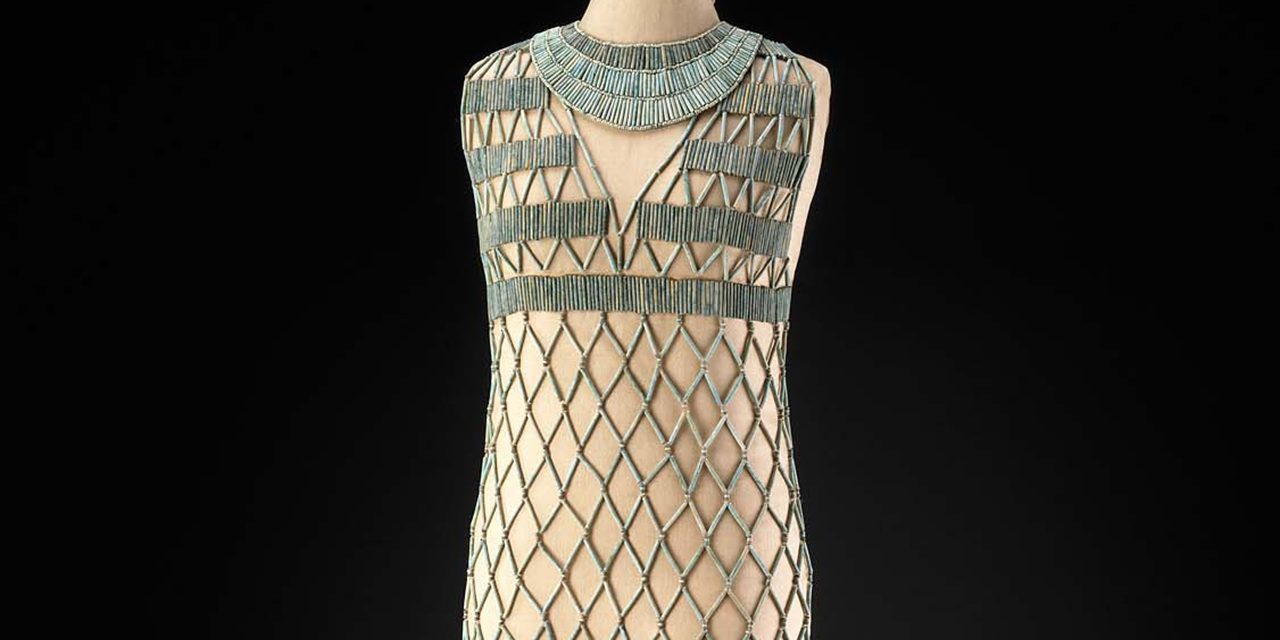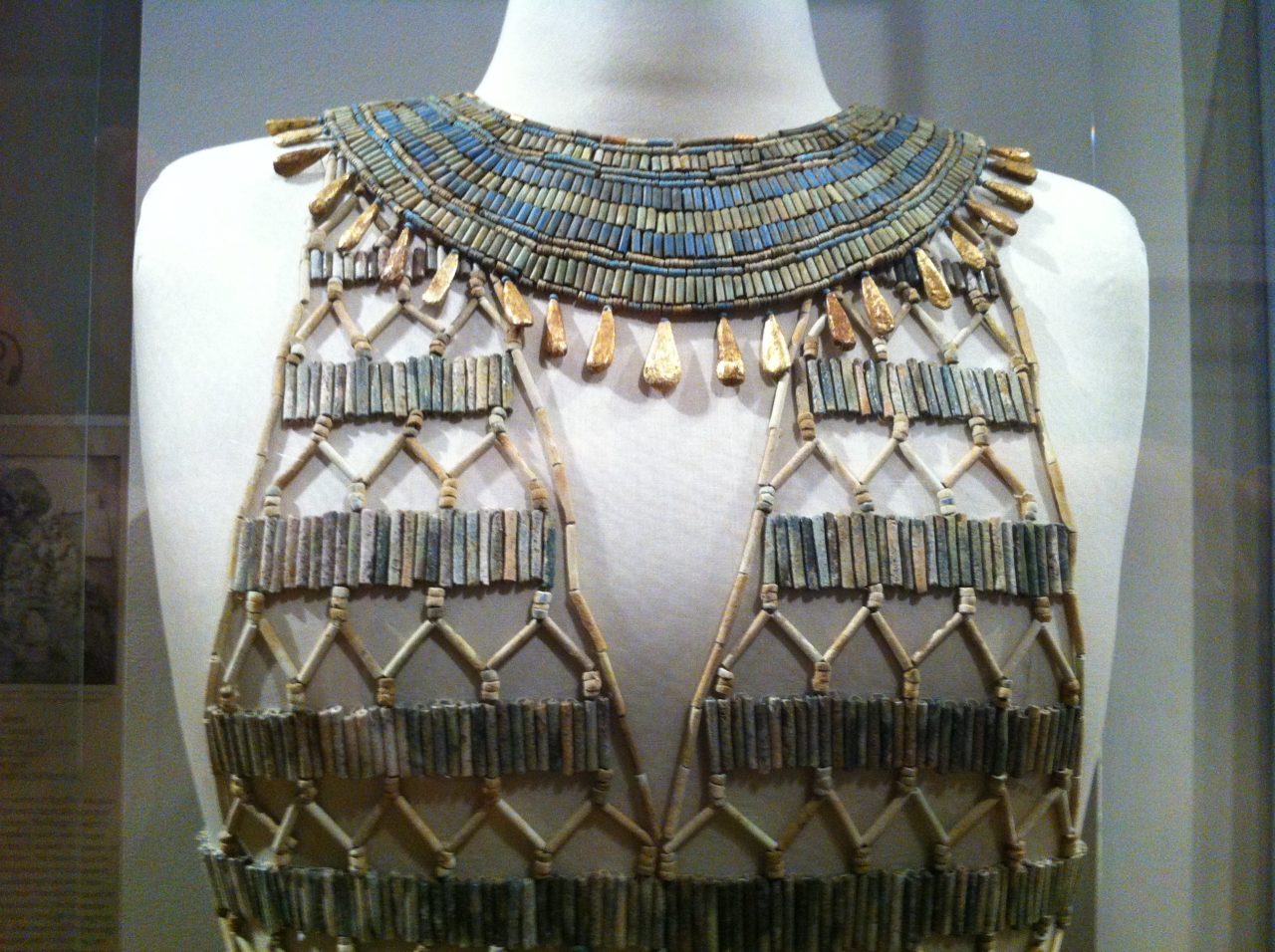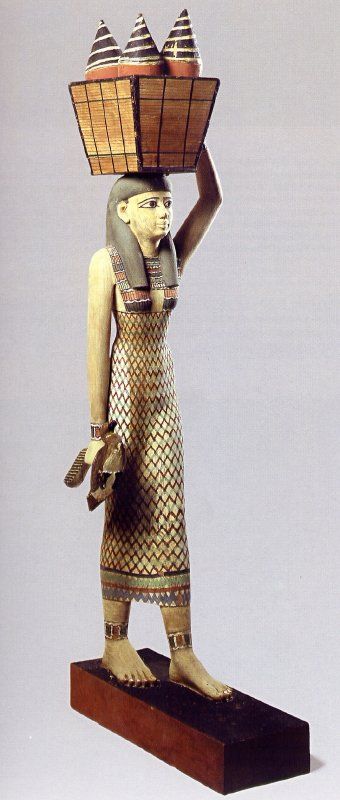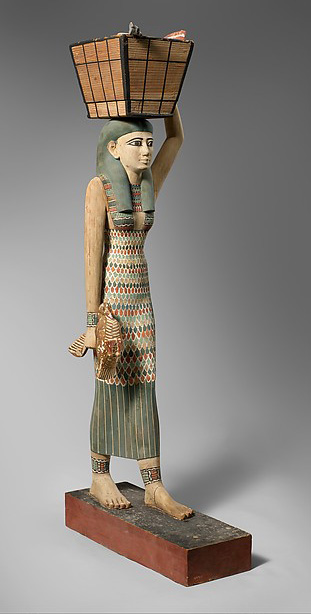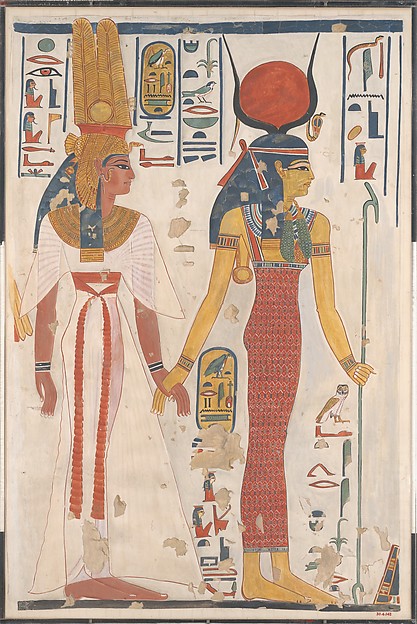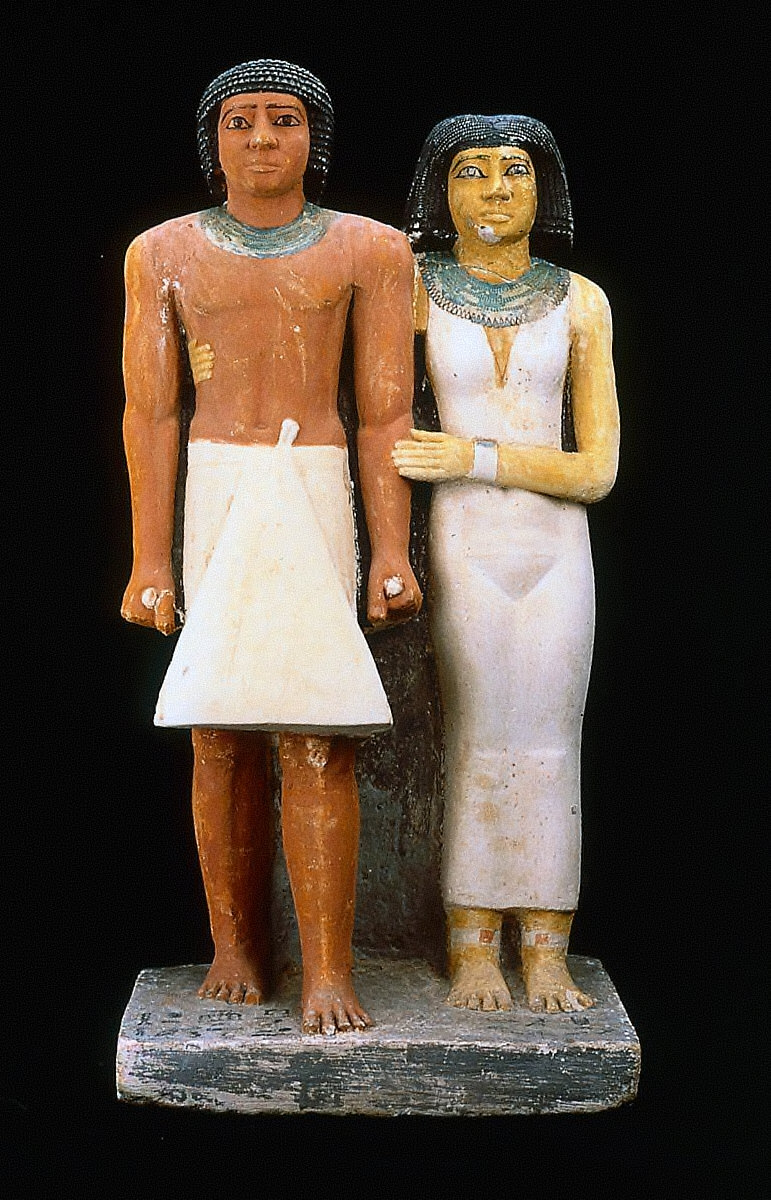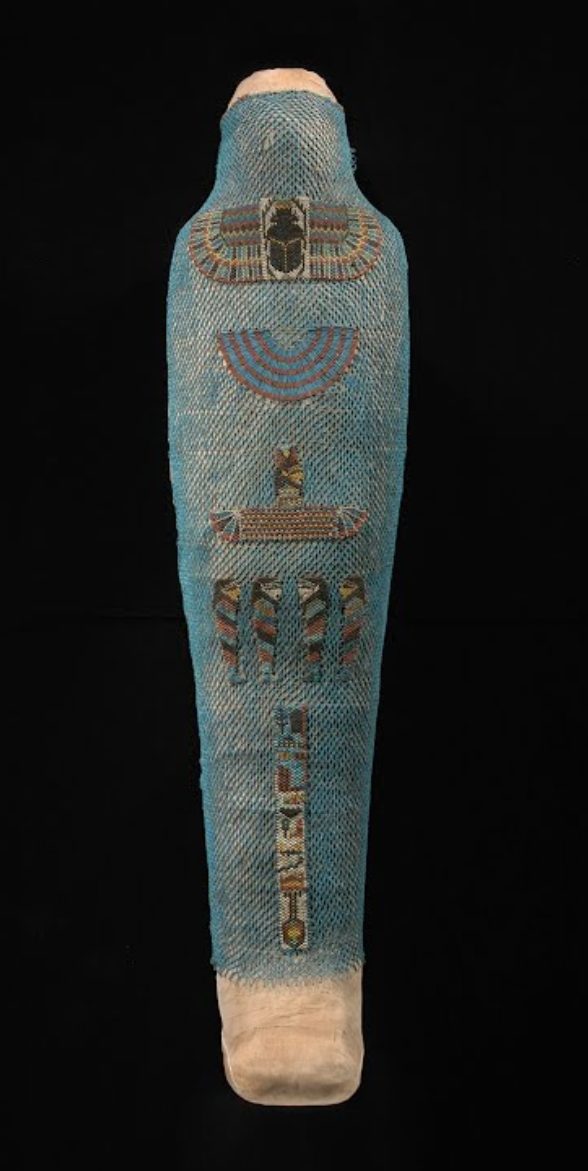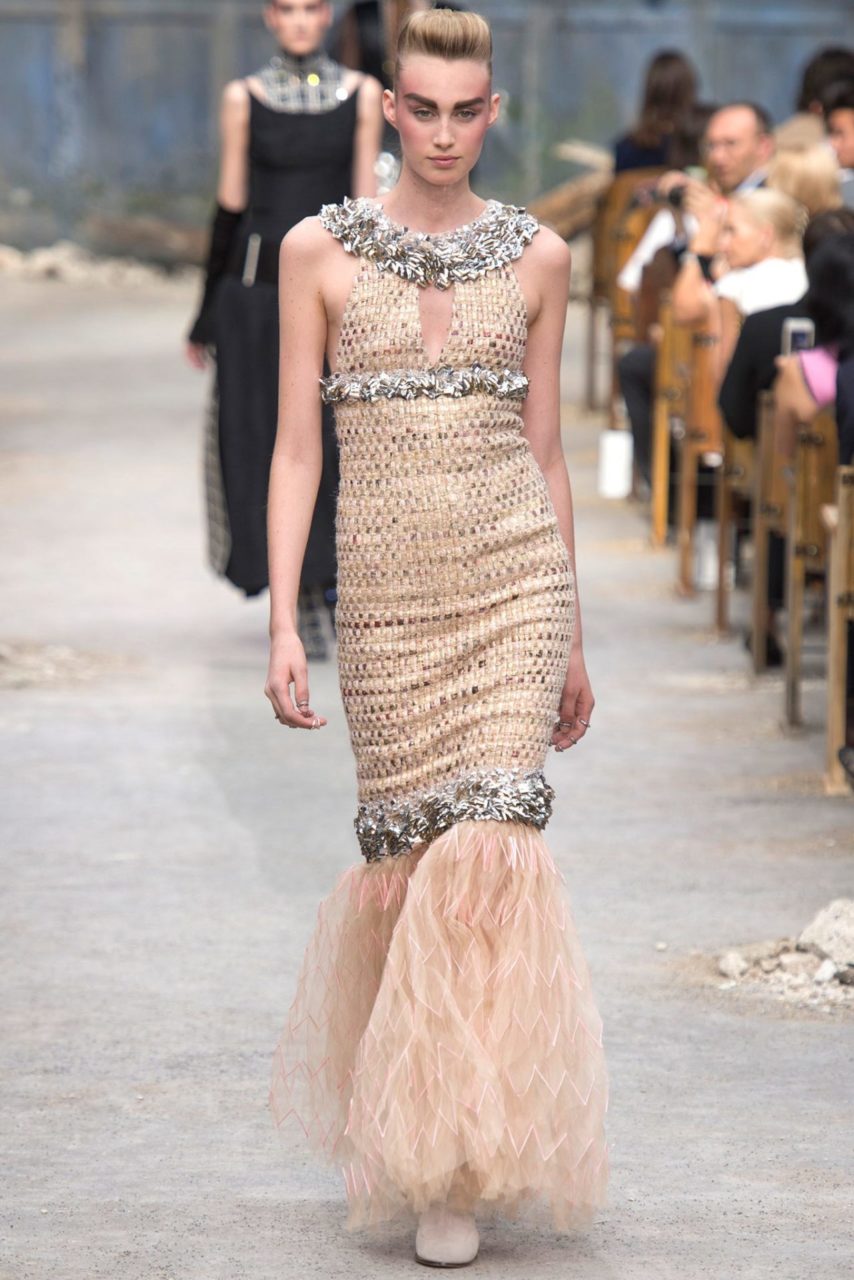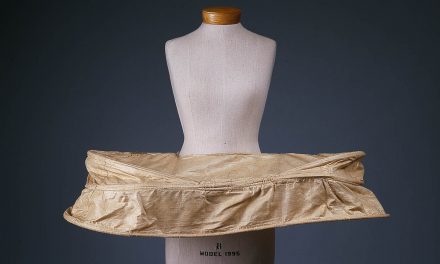A decorative sheath dress made of beads worn in ancient Egypt.
The Details
The Museum of Fine Arts, Boston has two reconstructed Egyptian beadnet dresses in its collection (Figs. 1-3). Of Figure 2 (see also detail shot in Fig. 1), the MFA writes:
“Depictions of women in Egyptian art occasionally feature garments decorated with an overall lozenge pattern. This design is believed to represent beadwork, which was either sewn onto a linen dress or worked into a separate net worn over the linen. This beadnet dress is the earliest surviving example of such a garment. It has been painstakingly reassembled from approximately seven thousand beads found in an undisturbed burial of a female contemporary of King Khufu. Although their string had disintegrated, a few beads still lay in their original pattern on and around the mummy, permitting an accurate reconstruction. The color of the beads has faded, but the beadnet was originally blue and blue green in imitation of lapis lazuli and turquoise.”
The MFA’s other dress (Fig. 3), which is from several hundred years later, features the same overall design but fewer beads (3000 vs. 7000, according to DK Fashion 16). Both body-skimming dresses feature the high waistbands and straight shoulder straps and fringed hems of mitra shells.
Fig. 1 - Maker unknown (Egyptian). Beadnet dress, detail, Old Kingdom, Dynasty 4, Reign of Khufu, 2551 - 2528 BCE. Faience and gold; 44 x 113 cm (17 5/16 x 44 1/2 in). Boston: Museum of Fine Arts, 27.1548.1. Findspot: Egypt, Giza, Tomb G 7440 Z. Source: Jennifer Brown
Fig. 2 - Maker unknown. Beadnet dress, Egyptian, Old Kingdom, Dynasty 4, Reign of Khufu, 2551 - 2528 BCE. Faience and gold; 44 x 113 cm (17 5/16 x 44 1/2 in). Boston: Museum of Fine Arts, 27.1548.1. Findspot: Egypt, Giza, Tomb G 7440 Z. Source: MFA Boston
Fig. 3 - Maker unknown. Beadnet dress, Egyptian, Old Kingdom, Dynasty 6, 2323–2150 BCE. Faience; 114.3 x 73.7 cm (45 x 29 in). Boston: Museum of Fine Arts, 33.1020.1. Findspot: Giza, Egypt. Source: MFA Boston
Fig. 4 - Maker unknown (Egyptian). Beadnet dress, Old Kingdom, Dynasty 5, ca. 2400 BCE. Faience. London: Petrie Museum of Egyptian Archaeology, UC17743-1. Findspot: Qau. Source: University College London
Athird surviving beadnet dress is in the collection of University College, London (Fig. 4), of which the Petrie Museum writes:
“Each of the 127 shells around the fringe are plugged with a small stone so that it would have emitted a rattling sound when the wearer moved.”
We also find artistic depictions of what are perhaps beadnet dresses in surviving sculptures (Figs. 5 & 6) and wall paintings (Fig. 7). [For more on the statues of offering bearers in Figs. 5 & 6, see the Met’s excellent video: “Sustenance” by Catharine Roehrig.]Of these artistic depictions, fashion historian Daniel Delis Hill writes in The History of World Costume and Fashion (2011):
“It is not clear, though, whether the brightly colored patterns depicted in wall paintings or on statuettes represent appliquéd beadwork, embroidery, featherwork, or designs woven into the fabric. Examples of all of these decorative treatments have been found.” (47)
Some suggest that the beaded dresses “could be made of leather thonging” (DK Fashion 16).
Hill further suggests that “dresses made entirely of beaded nets … may have been worn over the nude body or as an ornamental overskirt” (47). Scholars are divided on this point. It is likely the beadnet dress was sewn onto or worn over a plain linen sheath dress like that seen in Figure 8. Notably its function was not only decorative, but also functional as it would help the dress fit the contours of the body more closely.
According to the Petrie Museum, Guy Brunton, the archeologist who discovered the dress in Figure 4:
“commented that the dress reminds us of the story of King Sneferu going on a sailing trip on the palace lake, recorded on a papyrus dating from around 1800 BC. The King gets twenty young women to row a boat and, to relieve his boredom, orders: ‘Let there be brought to me twenty women with the shapeliest bodies, breasts and braids, who have not yet given birth. And let there be brought to me 20 nets. Give those nets to these women in place of their clothes!'”
While relatively few beadnet dresses survive, beadnet coverings for mummies (Fig. 9) have been found more frequently (Boucher 92).
Fig. 5 - Artist unknown (Egyptian). Statue of Offering Bearer, ca. 1981–1975 BCE, early reign of Amenemhat I, Dynasty 12, Middle Kingdom. Wood, gesso, paint; h. 112 cm (44 1/8 in). Cairo: Egyptian Museum. Findspot: Thebes, Southern Asasif, Tomb of Meketre. Source: Pinterest
Fig. 6 - Artist unknown (Egyptian). Statue of Offering Bearer, ca. 1981–1975 BCE, early reign of Amenemhat I, Dynasty 12, Middle Kingdom. Wood, gesso, paint; h. 112 cm (44 1/8 in). New York: The Metropolitan Museum of Art, 20.3.7. Findspot: Thebes, Southern Asasif, Tomb of Meketre. Rogers Fund and Edward S. Harkness Gift, 1920. Source: Metropolitan Museum of Art
Fig. 7 - Artist unknown (Egyptian). Queen Nefertari being led by Isis, New Kingdom, Dynasty 19, ca. 1279–1213 BCE. New York: The Metropolitan Museum of Art, 30.4.142. Original from Egypt, Upper Egypt, Thebes, Valley of the Queens (Biban el-Malikat), KV 66 (Tomb of Nefertari). Tempera on paper facsimile by Charles K. Wilkinson. Source: Metropolitan Museum of Art
Fig. 8 - Artist unknown (Egyptian). Pair statue of Ptahkhenuwy and his wife, Old Kingdom, Dynasty 5, ca. 2465–2323 BCE. Painted limestone; h: 70.14 cm (27 5/8 in). Boston: Museum of Fine Arts, 06.1876. Findspot: Egypt, Giza, tomb G 2004. Source: MFA Boston
Fig. 9 - Maker unknown (Egyptian). Mummy of Inamonnefnebu, 700 - 650 BCE. Faience; 155 cm. Leiden: Rijksmuseum van Oudheden. Source: Google Arts & Culture
Arts and Humanities Through the Eras (2005) notes that beadnet dresses seem to have been more popular in the Old and Middle Kingdoms:
“Bead-net dresses were often worn over V-neck dresses as well as wraparound dresses and were constructed in geometric patterns. Two archaeological examples date to the Old Kingdom. The beads are cylinders of blue or green faience threaded into a diamond pattern. In the artistic evidence the bead-net dresses are worn over a wraparound dress. In art the bead-net dresses are fairly common in the Old and Middle Kingdoms, but decline in number during the New Kingdom.”
Its Afterlife
In Fall 2013, both Temperly London’s ready-to-wear (Fig. 10) and Chanel’s couture lines (Fig. 11) showed strong inspiration from Egyptian beadnet dress styles. Solange Knowles wore a beadnet custom Swarovski crystal dress created by Erickson Beamon to perform on “Saturday Night Live” in November 2016 (Fig. 12).
Fig. 10 - Alice Temperley for Temperley London (British, 1975-). Ready-to-wear dress, Fall 2013. Model: Margot Milani. Photograph by Yannis Vlamos / InDigital | GoRunway. Source: Vogue
Fig. 11 - Karl Lagerfeld for Chanel (German, 1933-). Couture dress, Fall 2013. Model: Dauphine McKee. Photograph by Yannis Vlamos / InDigital | GoRunway. Source: Vogue
Fig. 12 - With Swarovski Erickson Beamon. Custom crystal dress for Solange, November 2016. Swarovski crystals. Source: Elle
References:
- “Beadnet Dress.” Museum of Fine Arts, Boston, June 21, 2018. https://www.mfa.org/collections/object/beadnet-dress-146531.
- Boucher, François. 20,000 Years of Fashion: The History of Costume and Personal Adornment. Expanded ed. New York: H.N. Abrams, 1987. http://www.worldcat.org/oclc/979316852.
- Brown, Susan, ed. Fashion: The Definitive History of Costume and Style. New York: DK Publishing, 2012. http://www.worldcat.org/oclc/840417029.
- “Clothing.” Arts and Humanities Through the Eras, edited by Edward I. Bleiberg, et al., vol. 1: Ancient Egypt 2675-332 B.C.E. Gale, 2005, pp. 91-97. Gale Virtual Reference Library, http://libproxy.fitsuny.edu:2540/apps/doc/CX3427400059/GVRL?u=fitsuny&sid=GVRL&xid=af30c9b6. Accessed 7 Aug. 2018.
- Hill, Daniel Delis. History of World Costume and Fashion. Upper Saddle River, NJ: Pearson Prentice Hall, 2011. http://www.worldcat.org/oclc/768100950.
- “Mummy of Inamonnefnebu – Google Arts & Culture.” Google Cultural Institute. Accessed August 7, 2018. https://artsandculture.google.com/asset/mummy-of-inamonnefnebu/RQHBQRZcxv6nTw.
- The Met. 82nd & Fifth: “Sustenance” by Catharine Roehrig. Accessed August 7, 2018. https://www.youtube.com/watch?v=B4k9JklNrTk.
- UCL. “Bead Net Dress.” UCL CULTURE, October 25, 2016. https://www.ucl.ac.uk/culture/petrie-museum/bead-net-dress.

